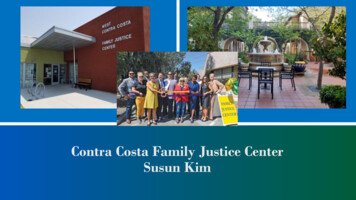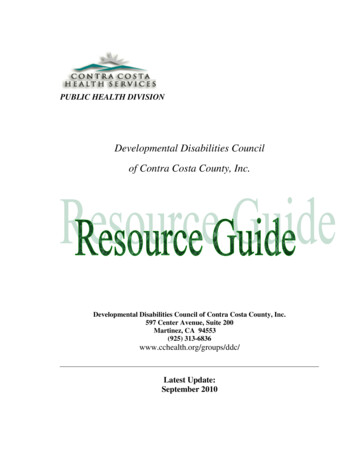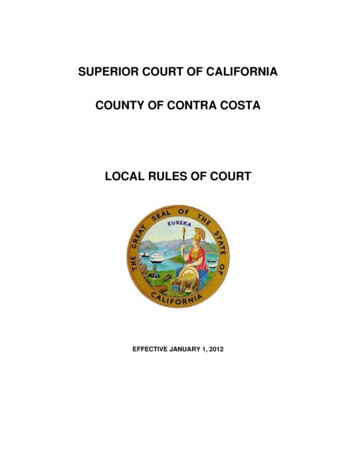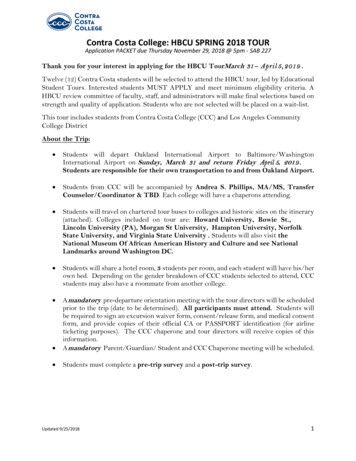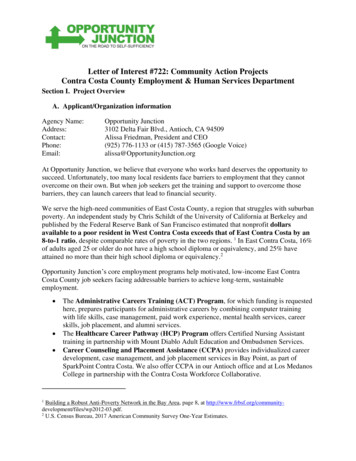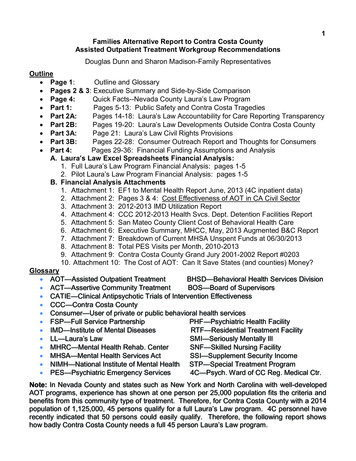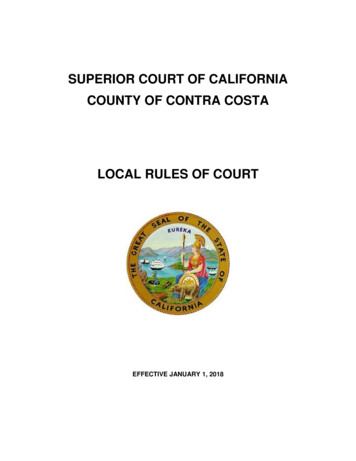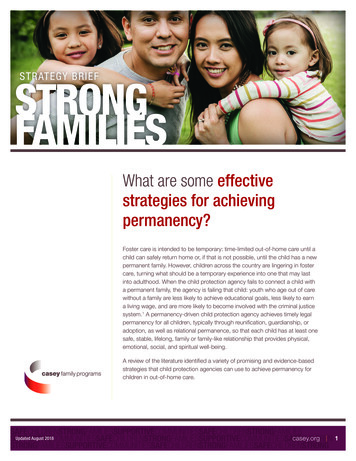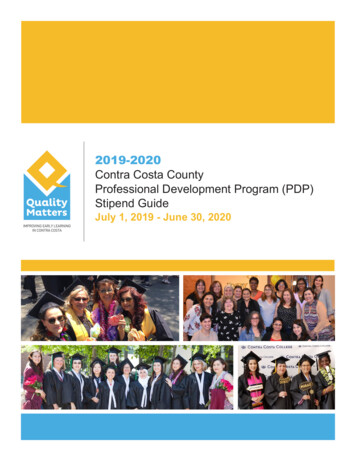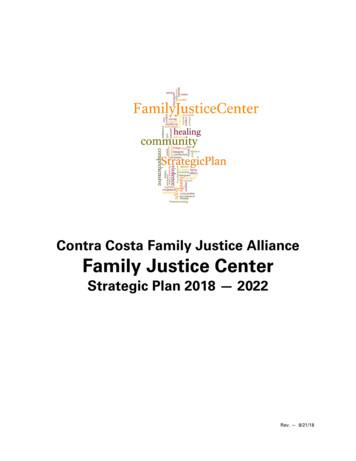
Transcription
Contra Costa Family Justice AllianceFamily Justice CenterStrategic Plan 2018 — 2022Rev. — 8/21/18
IntroductionFamily Justice Center (Family Justice, or the Center)conducted its strategic planning process in 2016-2017 to set a five-yeardirection for program and organizational development. The process included internal planningsessions with the Staff and Board of Directors; discussions with Family Justice partners, networkmembers, and other community organizations; a focus group with community members involvedin the community fellowship program; and interviews with community stakeholders, funders,and family justice centers and violence prevention programs in the Bay Area and Sacramento.The plan reflects the development and progress of the Center in its emerging role within theecosystem of violence and abuse prevention organizations and agencies in Contra Costa County.Key to this next five-year arc will be Family Justice’s position as a hub organization fosteringcollaboration, partnership, and collective impact in the wide-ranging and diverse multi-sectorapproach to family and intimate partner violence assistance, intervention, and prevention. Overthe next five years, the Center’s driving focus will be on creating a stronger ecosystem of publicagencies, organizations, community group, and community members committed to reducing andpreventing family violence, and promoting systems change.Family Justice Center Strategic Plan 2018 — 2022 2
Strategic QuestionsThe following are strategic questions that helped ground theassessment processes and discussions during the strategic planningprocess. These questions also framed the development of the Family Justice Strategic PlanningGoals.1. What is the unique role played by the Center?2. What is the ultimate change and impact the Center can bring about for the violenceprevention field in Contra Costa County, the Bay Area, and beyond?3. How will the Center strengthen the ecosystems of providers, agencies, and communityorganizations serving violence survivors and their families?4. What is the role of the Center in filling gaps in programs and services?5. How will the Center measure success and impact?Family Justice Center Strategic Plan 2018 — 2022 3
Mission, Vision & ValuesEach strategic planning process is built from review oforganizational mission, and the four elemental questions that are the cornerstone of everyorganization: Why do we do what we do (purpose and fundamental change)?Who do we do it on behalf of (stakeholders)?What do we do (strategies)? andHow to do it (values and principles)?The Center has established the following organizational foundations for its strategic plan:Mission: Our mission is to bring together our community to support the healing of familyviolence survivors, and to integrate capable partners with a comprehensive service approach torenew individuals and our community from the trauma of interpersonal violence: domesticviolence, sexual assault, child abuse, elder abuse, and human trafficking.Vision: We envision a vibrant community free from coercion and fear. In achieving that, ourcenter is a community hub for education, comprehensive and integrated services in the pursuit ofjustice, hope, health, and healing.Primary Stakeholders:The Center consists of a robust set of public and private stakeholders including core publicagencies like law enforcement, health, and community services.Values: We believe: Demonstrating respect and compassion brings out the best in everyone we encounter.A safe, dynamic, inclusive and innovative environment promotes hope and healing.Integrity is paramount in all our efforts.Justice and accountability are vital to a strong community.Collaboration is essential to delivering excellence to people.Family Justice Center Strategic Plan 2018 — 2022 4
External Issues & TrendsThrough Staff and Board discussions, focus groups, andstakeholder interviews, the Center identified key external issues and trendsthat will influence its work over the next five years. These issues and trends can shape theCenter direction over the next five years, either by advancing its mission, or impending itsprogress.General Opportunities — Events, issues, and trends that could help move the work of theCenter forward over the next 5 years. Changing in health care systems and policies, particularly regarding whole person careand violence prevention programs, can increase client and community awareness of IPVservices and resources, and create additional supportive services. Increased research toward developing a more family-centered service model forviolence prevention can provide support and momentum for new strategies that serve thewhole family, including children, and those responsible for harm in the family. Public awareness, community education, and broader public support can result fromincreased community dialogue, shifts in attitudes and culture around IPV and otherviolence issues, and linkages between the IPV issue and other violence and social issuesand problems faced by clients and families. New funding and sustainability opportunities that can help support long-term work onIPV and violence prevention. Increased attention on building the long-term capacity of community organizationsand public agencies can also help ensure a more stable future for communityorganizations, agencies, and providers serving clients and families affected by IPV.General Threats — Events, issues, and trends that could block the work of the Center overthe next 5 years. The reactionary national/global political environment of the last year may usher inunfavorable political conditions that influence and reverse local policies, communityattitudes, culture, and government commitment to reducing and preventing IPV. Changes in health care systems and programs, particularly from the national level,may drastically hinder violence reduction and prevention efforts. Reductions in public funding and stretched community resources can cause publicagencies, organizations, and providers to cut-back on services, and focus instead on theother priority social and economic issues affecting the lives of survivors and theirfamilies.Family Justice Center Strategic Plan 2018 — 2022 5
Changing demographics including an increase in the senior and immigrant populationsin the County.Funding and sustainability issues for IPV community resources can drastically reduceboth the expanse of services and programs as well as their effectiveness.Challenges to strengthening relationships between allies and partners — communityorganizations, victims’ advocates, government agencies, and law enforcement, can dimthe future of partnerships and collaboration.Issues and Trends Specifically Affecting Agencies and Providers.In addition to the general trends cited above, internal and external stakeholders identifiedissues and trends for agencies and providers assisting IPV clients, and the benefits andchallenges of multisystem collaboration that is so critical to effective intervention andprevention.Increasing agency and provider capacity. The Family Justice Center has focused its lastfive years on creating a more effective system of agencies, providers, and communityorganizations to serve the needs of clients and families facing IPV and other forms of personalviolence. Critical to this work are the strength, capacity, and resources of these partners, andtheir ability and willingness to work together to better serve clients and their communities.Family Justice partners and providers identified these assets that are needed over the next 5years to remain effective and sustainable: More training, capacity-building programs, and resources to more effectively serviceclients and their families. Strategies for expanding services across the county while also managing limitedorganizational resources: accessing additional service sites, and outreach to harder-toreach communities (e.g., barriers created by language, culture, immigrant status, andother diversity/equity issues). Developing IPV service models with a more holistic family approach; stressing long-termsupport and alternatives in addition to short-term services and interventions; anddeveloping alternatives in addition to law enforcement/prosecutorial models. Strengthening community education and information directing clients to availableservices and programs, and alternatives for increasing their personal safety long-term.Centrality of agency/provider cooperation and collaboration, and developing aneffective community collaborative. Family Justice’s creation of a dedicated “one-stop” centerfor comprehensive, effective, and accessible IPV services and programs is the foundation forreducing barriers experienced by clients seeking assistance, and coordinating services andreferrals. In addition to co-locating client services and resources, the Center is committed togreater cooperation, partnership and collaboration toward transforming one-stop centers intomore collaborative services. Family Justice providers and agencies identified the benefits of increasing joint work andcooperation among service partners. These included greater organization to organizationcommunication, more effective referrals, coordinated orientation and case-management,and joint training and capacity-building. As a result, providers have created strongerrelationships between organizations and across service systems.Family Justice Center Strategic Plan 2018 — 2022 6
Despite the immediate benefits of intergroup coordination and cooperation, there arechallenges to building collaboration among a diverse group of providers and systems:institutional, organizational, and sometimes legal/privacy barriers systems cooperation onreferral, coordinated case management; difficulties linking community services withpublic agencies and law enforcement processes.For collaboration to take hold, Family Justice will have to create systems andinfrastructure to enhance the collaborative strategies: shared vision and values; strongerinter group communication; improved access for harder-to-reach communities; andservices coordination processes: data-sharing, shared case management,language/interpreter support.To develop an effective IPV services collaborative, Family Justice will need to instillamong its network of agencies and providers a shared vision for support a more holistic,family-centered approach, and a stronger culture of collaboration: stronger organizationalrelationships and trust, open dialogue and communication, and greater transparency andaccountability.Family Justice should foster client and community empowerment that will eventuallybuild their involvement in preventing interpersonal violence.Importance of systems change, policy development, and advocacy to reducing andpreventing IPV. Family Justice stakeholders underscored the importance of creating a systemschange orientation for an IPV collaborative to be effective. This puts client assistance andviolence prevention in the context of policy development and improvement in systems for victimservices and prevention. The Center should expand its focus from interpersonal violence services and crisissupport to systems change and prevention. Collaboration among agencies, providers, andcommunity organizations is a foundational first step in systems change. Clients are moreeffectively served, access to services is improved, and programs become morecoordinated and efficient.Systems change includes shifting from solely supporting prosecution/victim-offendermodels to developing community empowerment and a holistic, family-centered approachthat focuses on strengthening the entire family. This shift will require further dialogueand relationship-building with public agencies and law enforcement.Systems change includes engaging and empowering clients and community organizationsin educating the community, and changing broader community’s awareness, attitudes andculture around interpersonal violence.Advocacy work should include promoting a values-based legislation and policy, that is,advancing and advocating for legislative and executive policies that further supportfamily-centered focus to violence reduction and prevention; organizing Family Justicenetwork members and other community organizations around issues; developingcommunity capacity in policy development and community organizing, and increasingclient and community engagement in violence prevention issues. This could also includelinking IPV issues within the context of other movements and areas of work affecting thissame universe of clients and families served by the Center.Within this large scope of advocacy work, The Center should prioritize advocacy areaswithin its capacity and resources, and partner with other organizations with advocacyexperience and capacity.Family Justice Center Strategic Plan 2018 — 2022 7
The Center and the Contra Costa Alliance to End Abuse will need to clarify theirrespective roles in the County policy and systems change: coordination ofwork, structure, sustainability, and leadership.Internal CapacityOver the past five years, Family Justice has developed from aone-stop center for convening relevant client services under one roof into a vehicle forcoordination and collaboration — a hub organization of providers and agencies that in the futurecan be aligned under shared vision and values, jointly plan for the future needs of clients andtheir families, and develop a collaborative infrastructure for program coordination, informationsharing and communication, and data-sharing and needs assessment.Along this path of development, Family Justice assessed its current capacities and status as abaseline for projecting its future needs as a hub.Family Justice: Current Accomplishments & Strengths. The Center has developed greater clarity in its mission and role in the violence reductionand prevention, and developed programs, structure, governance, and funding to effectuatethis role.It has strengthened its relationships and partnerships among organizations and agenciesserving the survivor community, and the community at-large. This has resulted incoordination of services and programs, joint program work and training, and creation ofcoordinating structures among providers and agencies serving victims and familyexperiencing intimate partner violence.The Center has developed effective programs focusing on client and familyempowerment and longer-term safety and security. Its array of services and programshave helped instill clients with greater self-esteem, resilience, and commitment toimprove their communities.It has increased its presence and recognition in the community through outreach, publicawareness, and community education.The Center has increased its role in advocacy for policy and systems change.The Center has taken leadership in coordinating efforts of the regions Family JusticeCenters.The Center has positioned itself to be able to fill in the big picture of effective suites ofservices by combining systemwide data sets and data collected at the Center.Family Justice: Current Areas For Improvement.Family Justice Center Strategic Plan 2018 — 2022 8
The Center should expand its capacity in evaluating program effectiveness and measuringimpact.It should continue to develop deeper collaboration among providers and agencies toensure communication, referrals, and data-sharing.The Center should further strengthen its public awareness and outreach work tostrengthen community awareness and prevention of intimate partner violence and itsimpact of clients and their families.It should continue to strengthen internal infrastructure, and the use of Center facilities asa site for community-building activities.The Center should develop a more family-centered model, addressing the holistic needsof the entire family.It should continue to build a more sustainable and financially stable organization.Family Justice Center Strategic Plan 2018 — 2022 9
Strategic Goals & OutcomesOverall framework for the Family Justice Center StrategicPlan: Building and strengthening the ecosystem of services, programs,and support for assisting individuals, families, and children involved in and affected by intimatepartner violence.This framework builds from the mission, vision and values of the Center, and answers thesekey questions: What is the change we are trying to create? And how does our change orientationalign with that of our primary stakeholders and other member of the community?Key stakeholders to effectively address IPV/family violence: Victims, and their children and families that receive services and assistance;Community providers and public agencies providing those services and assistance;The organized systems and networks of providers that strive to bring coherence andeffectiveness to the overall care and support of victims; andThe community-at large that must increase its awareness of the IPV issue, and build thesupport and prevention systems for reducing and ending violence.No one organization can do all these functions; it requires a broad ecosystem of services andsupport. Given the expanse of the work— from services and programs all the way to systemschange, innovative practices, and shifting community culture around violence, the Center shouldidentify and focus on where it can create the greatest impact and change, understand itsboundaries and limitations, and identify the key partners and collaborators for advancing theecosystem.For this strategic plan, the Center should its select areas of change, and prioritize work withinthe ecosystem in relation to the contributions of other organizations, agencies, and advocates.Family Justice Center Strategic Plan 2018 — 2022 10
The Center’s pivotal role within this ecosystem should be coordination and collaborativebuilding — ensuring the greatest level of synergy among the partners, allies, and stakeholdersand creating seamless support for IPV victims and their families.Goal 1:Create pathways for clients and families from crisis-support to long-term safety.Rationale. Family Justice partners and allied community providers deliver a broadspectrum of services and support for victims, their children, and families. The Centeritself also provides limited direct services (Navigation) and assistance to victimclients and community members. To maximize its impact, the Center shouldprioritize those programs and services that explicitly empower victim and communitymembers to connect with and engage in work to reduce violence, and advocate forprograms, activities, and policies that can prevent violence. The Center should alsocapitalize on the interconnections it creates, relationships created among providers,flexibility and customization of services in order to attract new partners and servicesto meet the individual needs of clients.Goal 2:Strengthen ecosystem collaboration, leveraging the collective contributions andstrengths of Family Justice partners and stakeholders.Rationale. If developing the capacity and relationships among network partners andproviders is a first step in creating a more effective ecosystem, the next, critical stepis building a stronger, more structured collaborative. Such a collaborative — multidisciplinary, multi-sector, joining public agencies, community providers, andcommunity members, is clearly a long-term aspiration fraught with tremendouspolitical and organizational challenges. The Center should prioritize the building of astronger collaborative network that extends beyond co-located services and moreefficient coordination and partnerships in services and program. Collaboration shouldalso include shared values and planning, coordinated implementation strategies anddata-sharing, and a common policy/advocacy agenda.Goal 3:Develop the capacity of Family Justice partners and other service providers tobest serve clients and families.Rationale. The overall effectiveness of the ecosystem depends on the strength andcapacity of the public agencies and community providers to deliver assistance andsupport from a family-centered perspective. The Center can ensure this effectivenessby prioritizing the strengthening of partners and providers. Building long-termcapacity and promoting shared experiences, resources, and best practices will lead tostronger networking and collaboration.Goal 4:Build greater community awareness and understanding of strategies to reduceand prevent IPV.Rationale. Long-term changes to community norms and acceptance of violence, andawareness of services and programs to assist victims, etc. all depend on policyadvocacy, education, cultural shifts, and improved interaction and partnership ofpublic and community systems for violence assistance and prevention. This does nothappen on its own, and without leadership. The Center should prioritize work thatfosters change with the community-at-large to create broader community prevention.Family Justice Center Strategic Plan 2018 — 2022 11
Goal 5:Strengthen Family Justice as a collaborative hub for the ecosystem.Rationale. The ability of the Center to provide this wide spectrum of organizationalservices and support depends on its own capacity-building focus. There should be aconcerted effort to grow the type of capacity needed to lead a multisystemcollaborative, including contributing leadership and expertise regarding theintersection between different forms of interpersonal violence, and remaining neutralon polarizing issues. The Center should prioritize building the specific roles andfunctions of a hub organization, in order to provide collaborative leadership, vision,and coordination. It can adapt collaborative approaches from collective impact hubmodels, and deliberately build a more all-sided model over time. (See Appendices,Collaborative Hubs.)The proposed Family Justice strategic planning goals create an expansive program for thenext five years. The secret to the implementation of such an ambitious strategic plan will behaving clear agreements and commitments to specific outcomes (desired five-year changes) foreach of the goals.From these outcomes, Center Staff and Board will be able to prioritize the set of strategiesthat can meet those goals and outcomes, and measure its progress toward the fulfillment of thestrategic plan.The following sections provide a model for: Affirming strategic goals;Determining outcomes for each goal;Proposing and prioritizing strategies;Developing measures and indicators of progress; andCoordinating and reporting progress on the strategic plan.Family Justice Center Strategic Plan 2018 — 2022 12
Family Justice Center Strategic Plan 2018 — 2022Strategic Goals1.Create pathways for clientsand families from crisissupport to long-term safety.Possible Outcomes(Desired changes in behavior, actions,and relationships of key stakeholdersover the next 5 years.)Examples of Strategies(Set of actions used to achievethe goals and outcomes)a.Established pathways from crisis support to long termsafety.Increased utilization by clients of services andprograms.Community engagement and leadership in policyadvocacy and organizing work. Build organization-to-organization relationships basedon trust and sense of community.Shared values, principles, and strategies for betterserving clients, including whole family supportapproaches and flexibility in order to adjust tochanging client needs and environment.Stronger leadership from all partners.Aligned programs, services and joint programs andnew services. b.c.a.b.2.Strengthen ecosystemcollaboration, leveraging thecollective contributions andstrengths of Family Justicepartners and stakeholders.c.d. a.3.4.5.Develop the capacity ofFamily Justice partners andother service providers tobest serve clients and families.Build greater communityawareness of strategies toreduce and prevent IPV.Strengthen Family JusticeCenter as a collaborative hubfor the ecosystem.Enhanced knowledge, skills and capacities to addressIPV, including the needs of the whole family, harderto-reach populations and innovations.b. Stronger working relationships among partners,including shared information, communication, andreferrals, and space (meeting location and destinationto pathways of service.a. Greater community understanding of the IPV issuesand increased community awareness of the FamilyJustice Center.a. Abundant funding sources.b. Increased internal capacity of staff and board.c. Enhanced capacity to engage partners to undertakepolicy advocacy, community organizing andinnovations.d. Effective communication vehicle for the ecosystem.Family Justice Center Strategic Plan 2018 — 2022 Bring more long-term safety programs (e.g., family resiliencyand wellness programs) and increased connection to long termsafety programsKeep partners and bring new partners; and have more casemanagers.Support community fellowship, Project Connect, affinity circlesand other community advocacy opportunities.Build shared communication and information sharing processesand structures.Support joint strategies and programs that enhancecollaboration.Develop strategies for models for evaluating collectiveoutcomes (e.g., network report card) and measures for success.Develop collaborative leadership capacity.Develop clearer collaborative network membership conditions(benefits and responsibilities and degree to which partnersengage and participate).Develop functioning conflict resolution process with buy-infrom all partners.Foster communication, coordination and referrals.Support MDT’s, Partners Meetings, Family Justice Institute andother training opportunities.Facilitate building relationships and networking opportunities.Create a set of standards for client service.Establish initial training protocols and curriculum for partnersand staff.Improve branding and communication strategy, including socialmedia plan.Develop customized targeted outreach to diverse groups.Develop joint funding strategies and opportunities.Support internal capacity development and training.Keeping tab on big picture, national trends, innovations, outsideresources. Better media response. Being on top of externalissues.Increased data evaluation capacity. 13
EvaluationThe Strategic Plan will be a valuable long-range guide only ifit is also dynamic, flexible, and organic. To ensure the plan’s relevance and impact, the entireorganization should reflect upon and reaffirm the strategies and goals each year, and reinitiatethe process of developing department/program outcomes for the next 12-18 month planningperiod. This would also be an opportunity to review progress, and make modifications,alterations, and other mid-course corrections to keep the organization on its five-year course. The organization should review the strategies and outcomes from the previous planningperiod, and identify key areas of accomplishments and unfinished business. It shouldlook for alignment between what it has done, and its implementation commitments. Ifpossible, this should be done at the program level and admin/operation, and by the Board.The strategic goals should be reviewed and reaffirmed, or modified according to thecurrent context of the organization. Given the previous year’s work, the organizationshould prioritize among the goals for focus and attention.Strategies and outcomes should be developed for the next 12-18 months, taking intoaccount accomplishments and unfinished areas of work, including work in new oremerging areas not part of previous implementation plans.The accountability and monitoring processes should be reviewed and affirmed.Strategies and outcomes should be tailored at the program level, admin/operations, andthe Board, and integrated into the new implementation plan.As the organization moves through the strategic plan, this evaluation process will becomemore streamlined and straightforward, with regular reporting under the implementation plan.this could all be accomplished in one half-day planning session.Evaluating strategies, goals, and outcomes will ensure a relevant strategic plan, and keep theplan high in the organizational consciousness. It will also provide an opportunity for celebrationof progress, lifting of the organizational horizon, and recommitment to strategic direction at alllevels of the organization.In recognition and memory ofMichael J. Wong, 1951-2018.Family Justice Center Strategic Plan 2018 — 2022 14
AppendicesFamily Justice Center Strategic Plan 2018 — 2022 15
Strategic PlanningProcess StepsStrategy Sessions & Discussions Strategy Session 1.0, with Staff.FJC Board Strategy Session.Community Partners Focus Group.Community Fellows Focus Group.FJC Strategy Session 2.0, With Staff, Board & Community Partners.External Scan Interviews Gloria Sandoval, Executive Director, STAND.Melody Saint-Saens, Staff Attorney, Bay Area Legal Aid.Robert Uyeki, CEO, Y&H Soda Foundation.Marissa Tirona, formerly Director, Blue Shield Against Violence.Kathy Moore, Executive Director, California Partnership to End Domestic Violence.Nicolas Alexander, Director, Reentry Success Project.Cherri Allison, Executive Director, Stephen Murphy, Associate Director; Karla EliasFlores, Navigator Coordinator, Alameda County Family Justice Center.Review Committee, Board of Directors Diane BurgisKen CarlsonAngie CoffeeDana FilkowskiStephanie KangKay TittleFamily Justice Center Strategic Plan 2018 — 2022 16
Collaborative HubsFive Key Conditions for Collective Impact Collaboratives1.Shared values, vision, and common agenda: Partners share a common understanding of the issue and acollective approach to solving it though agreed-upon actions.2.Shared outcomes and metrics: Collecting data and metrics consistently across all participants ensuresefforts remain aligned and participants hold each other accountable.3.Mutually reinforcing implementation activities: Participants activities must be differentiated while still
Family Justice Center Strategic Plan 2018 — 2022 . . 8. The Center and the Contra Costa Alliance to End Abuse will need to clarify their respective roles in the County policy and systems change: coordination of work, structure, sustainability, and leadership. Internal Capacity . Over the past five years, Family Justice has developed from a
